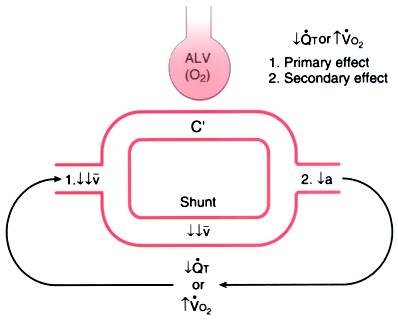 |
 |
Figure 17-27
Effect of a decrease in cardiac output or an increase
in oxygen consumption on mixed venous and arterial oxygen content. Mixed venous
blood ( ) either perfuses ventilated alveolar (ALV O2
) capillaries
and becomes oxygenated end-pulmonary capillary blood (c') or perfuses whatever true
shunt pathways exist and remains the same in composition (desaturated). These two
pathways must ultimately join together to form mixed arterial (a) blood. If cardiac
output (
) either perfuses ventilated alveolar (ALV O2
) capillaries
and becomes oxygenated end-pulmonary capillary blood (c') or perfuses whatever true
shunt pathways exist and remains the same in composition (desaturated). These two
pathways must ultimately join together to form mixed arterial (a) blood. If cardiac
output ( T) decreases or oxygen consumption
(V̇O2
) increases, or both the tissues
must extract more oxygen per unit volume of blood than under normal conditions.
Thus, the primary effect of a decrease in
T) decreases or oxygen consumption
(V̇O2
) increases, or both the tissues
must extract more oxygen per unit volume of blood than under normal conditions.
Thus, the primary effect of a decrease in  T
or an increase in V̇O2
is a decrease
in mixed venous oxygen content. The mixed venous blood with a decreased oxygen content
must flow through the shunt pathway as before (which may remain constant in size)
and lower the arterial content of oxygen. Thus, the secondary effect of a decrease
in
T
or an increase in V̇O2
is a decrease
in mixed venous oxygen content. The mixed venous blood with a decreased oxygen content
must flow through the shunt pathway as before (which may remain constant in size)
and lower the arterial content of oxygen. Thus, the secondary effect of a decrease
in  T or an increase in V̇O2
is a decrease in arterial oxygen content.
T or an increase in V̇O2
is a decrease in arterial oxygen content.

 |
![]() ) either perfuses ventilated alveolar (ALV O2
) capillaries
and becomes oxygenated end-pulmonary capillary blood (c') or perfuses whatever true
shunt pathways exist and remains the same in composition (desaturated). These two
pathways must ultimately join together to form mixed arterial (a) blood. If cardiac
output (
) either perfuses ventilated alveolar (ALV O2
) capillaries
and becomes oxygenated end-pulmonary capillary blood (c') or perfuses whatever true
shunt pathways exist and remains the same in composition (desaturated). These two
pathways must ultimately join together to form mixed arterial (a) blood. If cardiac
output (![]() T) decreases or oxygen consumption
(V̇O2
) increases, or both the tissues
must extract more oxygen per unit volume of blood than under normal conditions.
Thus, the primary effect of a decrease in
T) decreases or oxygen consumption
(V̇O2
) increases, or both the tissues
must extract more oxygen per unit volume of blood than under normal conditions.
Thus, the primary effect of a decrease in ![]() T
or an increase in V̇O2
is a decrease
in mixed venous oxygen content. The mixed venous blood with a decreased oxygen content
must flow through the shunt pathway as before (which may remain constant in size)
and lower the arterial content of oxygen. Thus, the secondary effect of a decrease
in
T
or an increase in V̇O2
is a decrease
in mixed venous oxygen content. The mixed venous blood with a decreased oxygen content
must flow through the shunt pathway as before (which may remain constant in size)
and lower the arterial content of oxygen. Thus, the secondary effect of a decrease
in ![]() T or an increase in V̇O2
is a decrease in arterial oxygen content.
T or an increase in V̇O2
is a decrease in arterial oxygen content.